Report on Homeostasis: Maintaining Internal Equilibrium in Biology
VerifiedAdded on 2019/09/20
|7
|972
|441
Report
AI Summary
This report provides a comprehensive overview of homeostasis, the process by which the human body maintains a stable internal environment. It delves into the roles of feedback regulation, particularly negative and positive feedback loops, in controlling critical parameters such as blood glucose levels, body temperature, and water content. The report explains the mechanisms of insulin and glucagon in regulating blood glucose, the body's response to temperature changes through sweating and shivering, and the kidney's function in water balance. It also touches on the consequences of homeostatic imbalance, such as in cases of kidney failure and Type 2 Diabetes. The report references key concepts and examples to illustrate the importance of homeostasis for overall health and well-being.
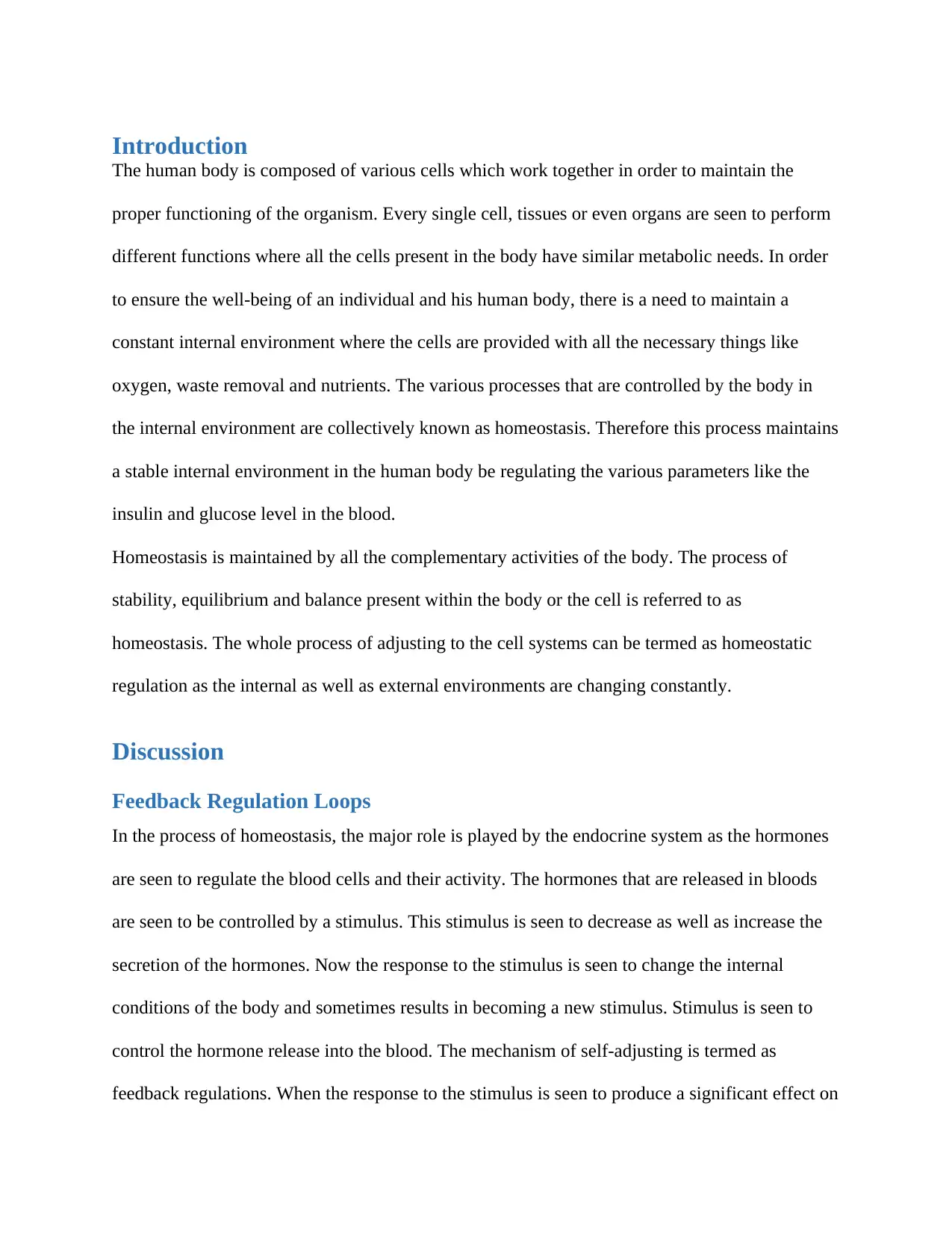
Introduction
The human body is composed of various cells which work together in order to maintain the
proper functioning of the organism. Every single cell, tissues or even organs are seen to perform
different functions where all the cells present in the body have similar metabolic needs. In order
to ensure the well-being of an individual and his human body, there is a need to maintain a
constant internal environment where the cells are provided with all the necessary things like
oxygen, waste removal and nutrients. The various processes that are controlled by the body in
the internal environment are collectively known as homeostasis. Therefore this process maintains
a stable internal environment in the human body be regulating the various parameters like the
insulin and glucose level in the blood.
Homeostasis is maintained by all the complementary activities of the body. The process of
stability, equilibrium and balance present within the body or the cell is referred to as
homeostasis. The whole process of adjusting to the cell systems can be termed as homeostatic
regulation as the internal as well as external environments are changing constantly.
Discussion
Feedback Regulation Loops
In the process of homeostasis, the major role is played by the endocrine system as the hormones
are seen to regulate the blood cells and their activity. The hormones that are released in bloods
are seen to be controlled by a stimulus. This stimulus is seen to decrease as well as increase the
secretion of the hormones. Now the response to the stimulus is seen to change the internal
conditions of the body and sometimes results in becoming a new stimulus. Stimulus is seen to
control the hormone release into the blood. The mechanism of self-adjusting is termed as
feedback regulations. When the response to the stimulus is seen to produce a significant effect on
The human body is composed of various cells which work together in order to maintain the
proper functioning of the organism. Every single cell, tissues or even organs are seen to perform
different functions where all the cells present in the body have similar metabolic needs. In order
to ensure the well-being of an individual and his human body, there is a need to maintain a
constant internal environment where the cells are provided with all the necessary things like
oxygen, waste removal and nutrients. The various processes that are controlled by the body in
the internal environment are collectively known as homeostasis. Therefore this process maintains
a stable internal environment in the human body be regulating the various parameters like the
insulin and glucose level in the blood.
Homeostasis is maintained by all the complementary activities of the body. The process of
stability, equilibrium and balance present within the body or the cell is referred to as
homeostasis. The whole process of adjusting to the cell systems can be termed as homeostatic
regulation as the internal as well as external environments are changing constantly.
Discussion
Feedback Regulation Loops
In the process of homeostasis, the major role is played by the endocrine system as the hormones
are seen to regulate the blood cells and their activity. The hormones that are released in bloods
are seen to be controlled by a stimulus. This stimulus is seen to decrease as well as increase the
secretion of the hormones. Now the response to the stimulus is seen to change the internal
conditions of the body and sometimes results in becoming a new stimulus. Stimulus is seen to
control the hormone release into the blood. The mechanism of self-adjusting is termed as
feedback regulations. When the response to the stimulus is seen to produce a significant effect on
Paraphrase This Document
Need a fresh take? Get an instant paraphrase of this document with our AI Paraphraser
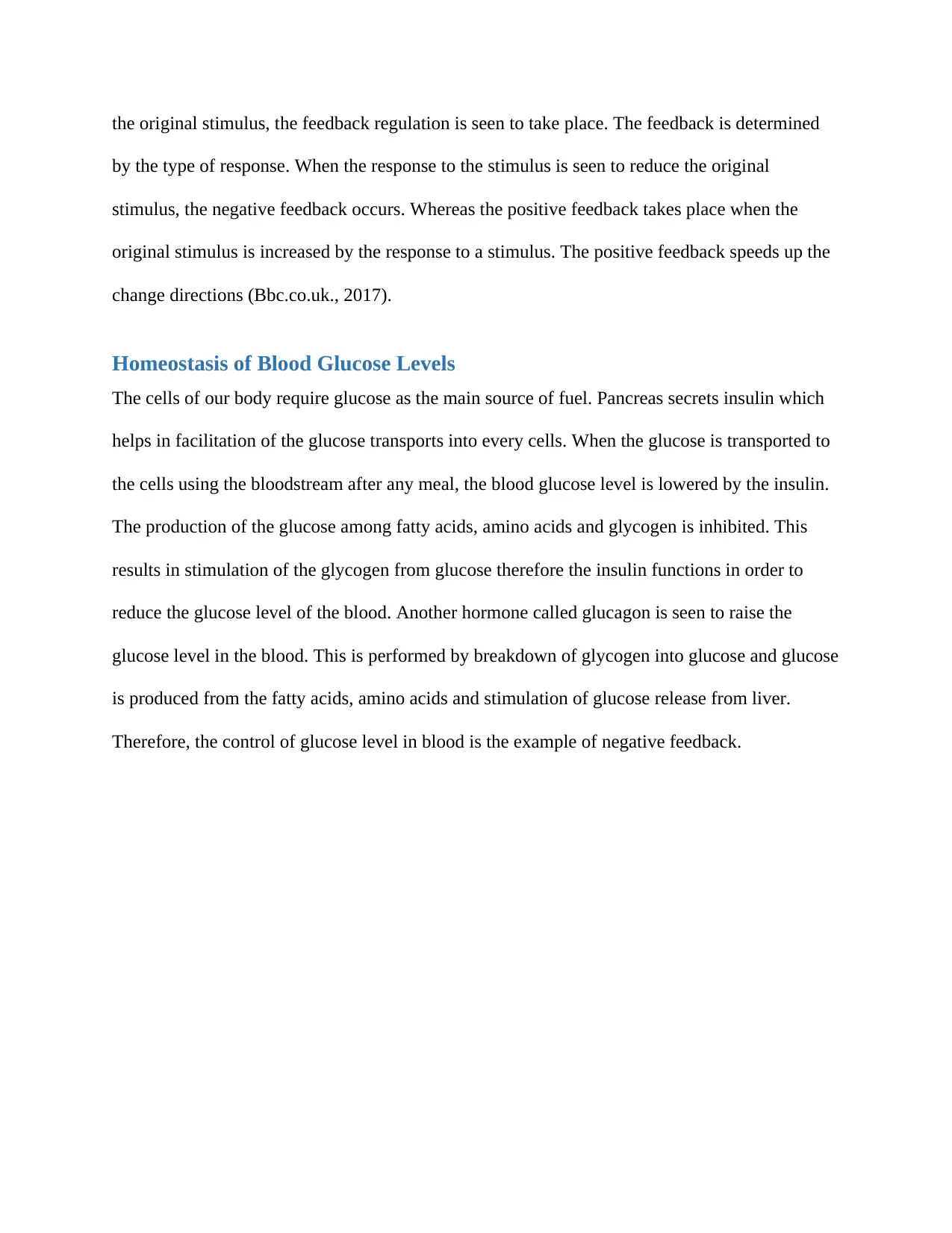
the original stimulus, the feedback regulation is seen to take place. The feedback is determined
by the type of response. When the response to the stimulus is seen to reduce the original
stimulus, the negative feedback occurs. Whereas the positive feedback takes place when the
original stimulus is increased by the response to a stimulus. The positive feedback speeds up the
change directions (Bbc.co.uk., 2017).
Homeostasis of Blood Glucose Levels
The cells of our body require glucose as the main source of fuel. Pancreas secrets insulin which
helps in facilitation of the glucose transports into every cells. When the glucose is transported to
the cells using the bloodstream after any meal, the blood glucose level is lowered by the insulin.
The production of the glucose among fatty acids, amino acids and glycogen is inhibited. This
results in stimulation of the glycogen from glucose therefore the insulin functions in order to
reduce the glucose level of the blood. Another hormone called glucagon is seen to raise the
glucose level in the blood. This is performed by breakdown of glycogen into glucose and glucose
is produced from the fatty acids, amino acids and stimulation of glucose release from liver.
Therefore, the control of glucose level in blood is the example of negative feedback.
by the type of response. When the response to the stimulus is seen to reduce the original
stimulus, the negative feedback occurs. Whereas the positive feedback takes place when the
original stimulus is increased by the response to a stimulus. The positive feedback speeds up the
change directions (Bbc.co.uk., 2017).
Homeostasis of Blood Glucose Levels
The cells of our body require glucose as the main source of fuel. Pancreas secrets insulin which
helps in facilitation of the glucose transports into every cells. When the glucose is transported to
the cells using the bloodstream after any meal, the blood glucose level is lowered by the insulin.
The production of the glucose among fatty acids, amino acids and glycogen is inhibited. This
results in stimulation of the glycogen from glucose therefore the insulin functions in order to
reduce the glucose level of the blood. Another hormone called glucagon is seen to raise the
glucose level in the blood. This is performed by breakdown of glycogen into glucose and glucose
is produced from the fatty acids, amino acids and stimulation of glucose release from liver.
Therefore, the control of glucose level in blood is the example of negative feedback.
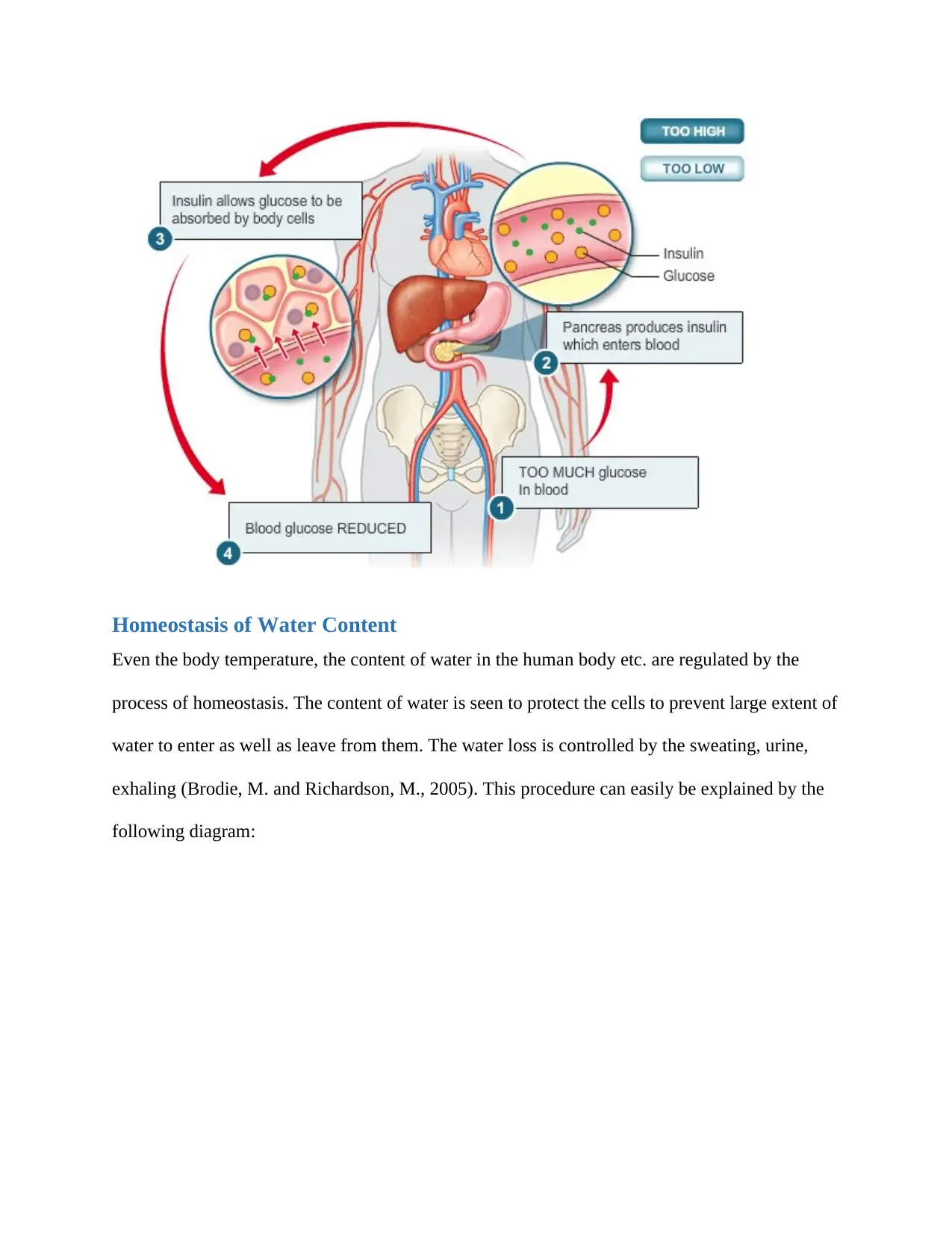
Homeostasis of Water Content
Even the body temperature, the content of water in the human body etc. are regulated by the
process of homeostasis. The content of water is seen to protect the cells to prevent large extent of
water to enter as well as leave from them. The water loss is controlled by the sweating, urine,
exhaling (Brodie, M. and Richardson, M., 2005). This procedure can easily be explained by the
following diagram:
Even the body temperature, the content of water in the human body etc. are regulated by the
process of homeostasis. The content of water is seen to protect the cells to prevent large extent of
water to enter as well as leave from them. The water loss is controlled by the sweating, urine,
exhaling (Brodie, M. and Richardson, M., 2005). This procedure can easily be explained by the
following diagram:
⊘ This is a preview!⊘
Do you want full access?
Subscribe today to unlock all pages.

Trusted by 1+ million students worldwide
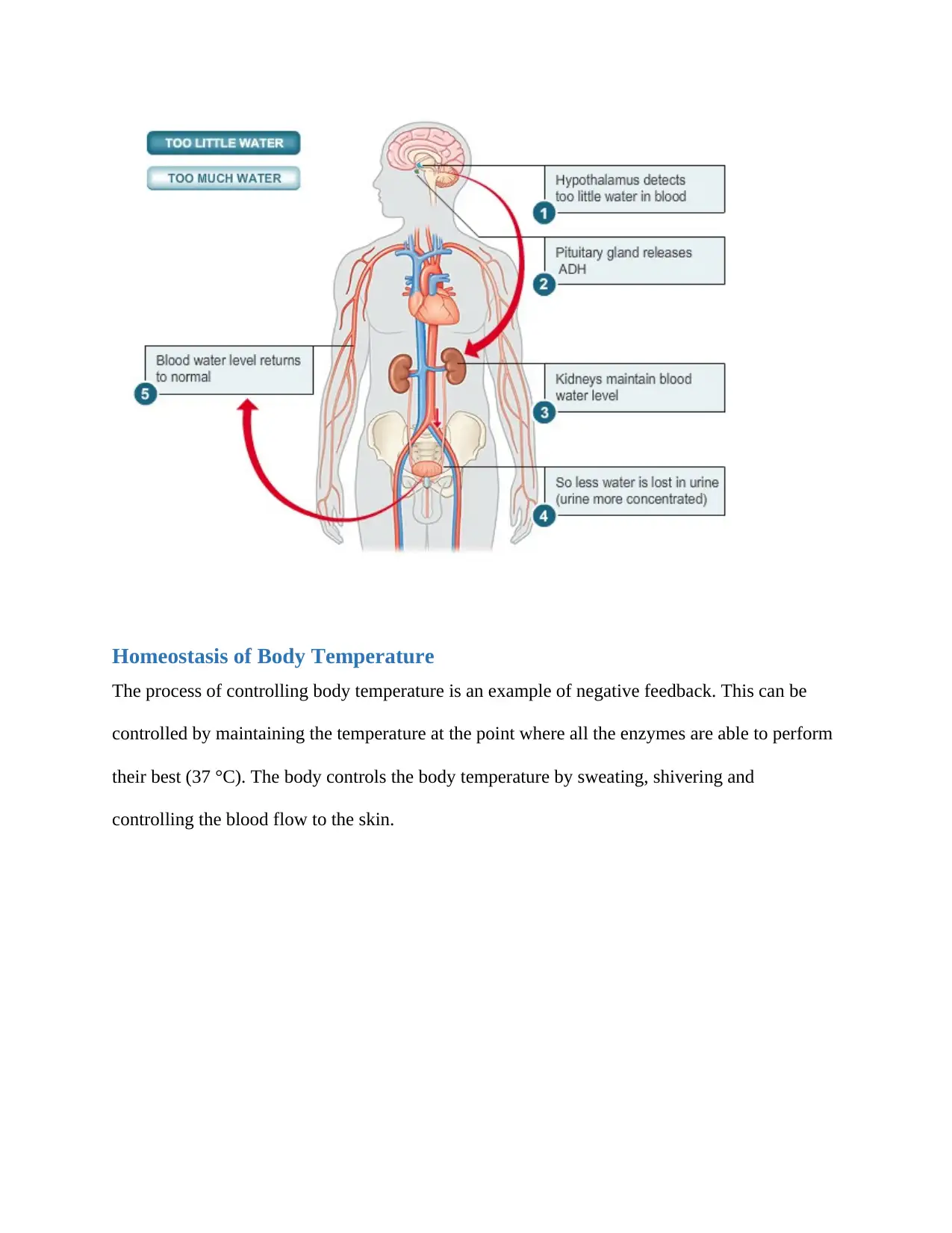
Homeostasis of Body Temperature
The process of controlling body temperature is an example of negative feedback. This can be
controlled by maintaining the temperature at the point where all the enzymes are able to perform
their best (37 °C). The body controls the body temperature by sweating, shivering and
controlling the blood flow to the skin.
The process of controlling body temperature is an example of negative feedback. This can be
controlled by maintaining the temperature at the point where all the enzymes are able to perform
their best (37 °C). The body controls the body temperature by sweating, shivering and
controlling the blood flow to the skin.
Paraphrase This Document
Need a fresh take? Get an instant paraphrase of this document with our AI Paraphraser
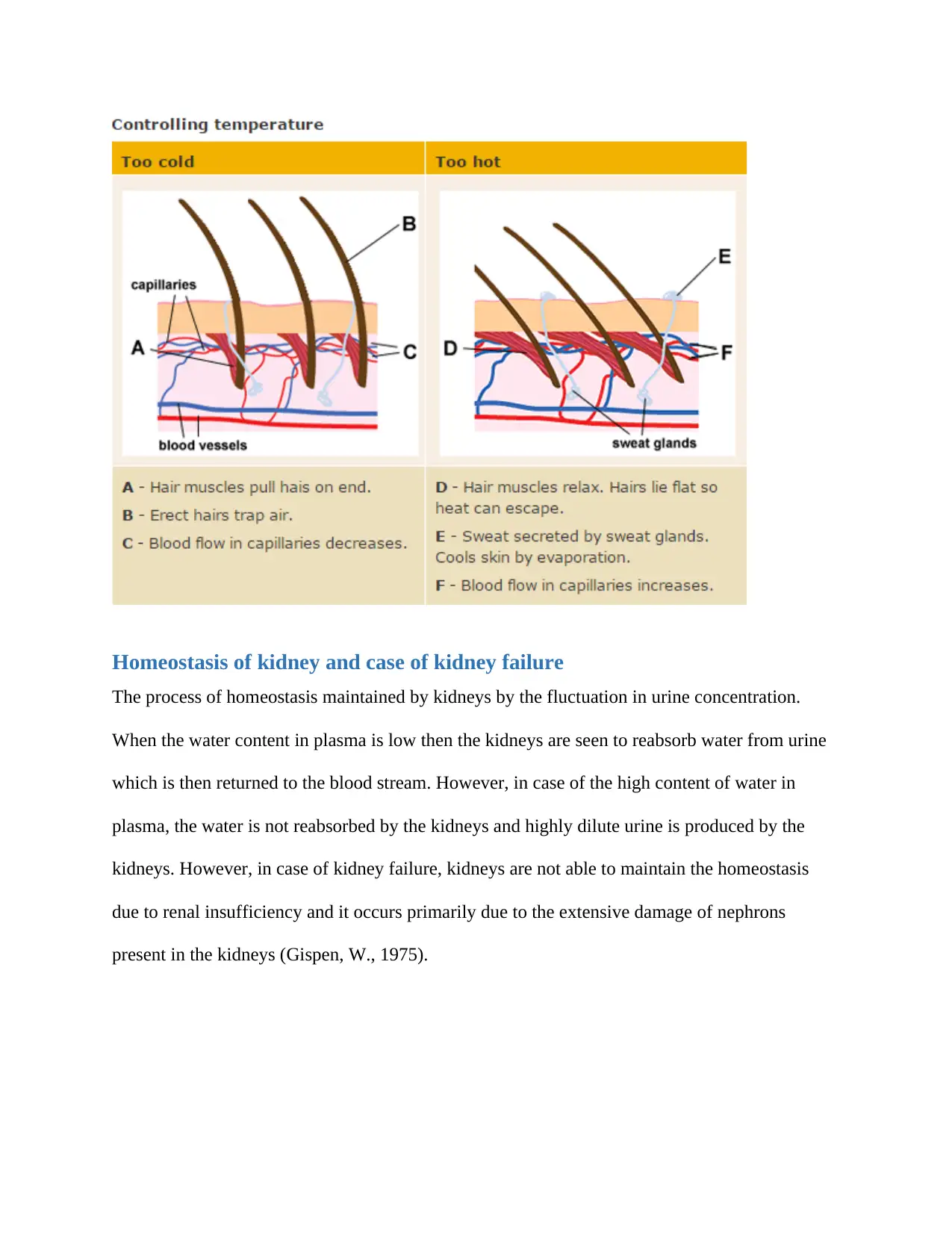
Homeostasis of kidney and case of kidney failure
The process of homeostasis maintained by kidneys by the fluctuation in urine concentration.
When the water content in plasma is low then the kidneys are seen to reabsorb water from urine
which is then returned to the blood stream. However, in case of the high content of water in
plasma, the water is not reabsorbed by the kidneys and highly dilute urine is produced by the
kidneys. However, in case of kidney failure, kidneys are not able to maintain the homeostasis
due to renal insufficiency and it occurs primarily due to the extensive damage of nephrons
present in the kidneys (Gispen, W., 1975).
The process of homeostasis maintained by kidneys by the fluctuation in urine concentration.
When the water content in plasma is low then the kidneys are seen to reabsorb water from urine
which is then returned to the blood stream. However, in case of the high content of water in
plasma, the water is not reabsorbed by the kidneys and highly dilute urine is produced by the
kidneys. However, in case of kidney failure, kidneys are not able to maintain the homeostasis
due to renal insufficiency and it occurs primarily due to the extensive damage of nephrons
present in the kidneys (Gispen, W., 1975).
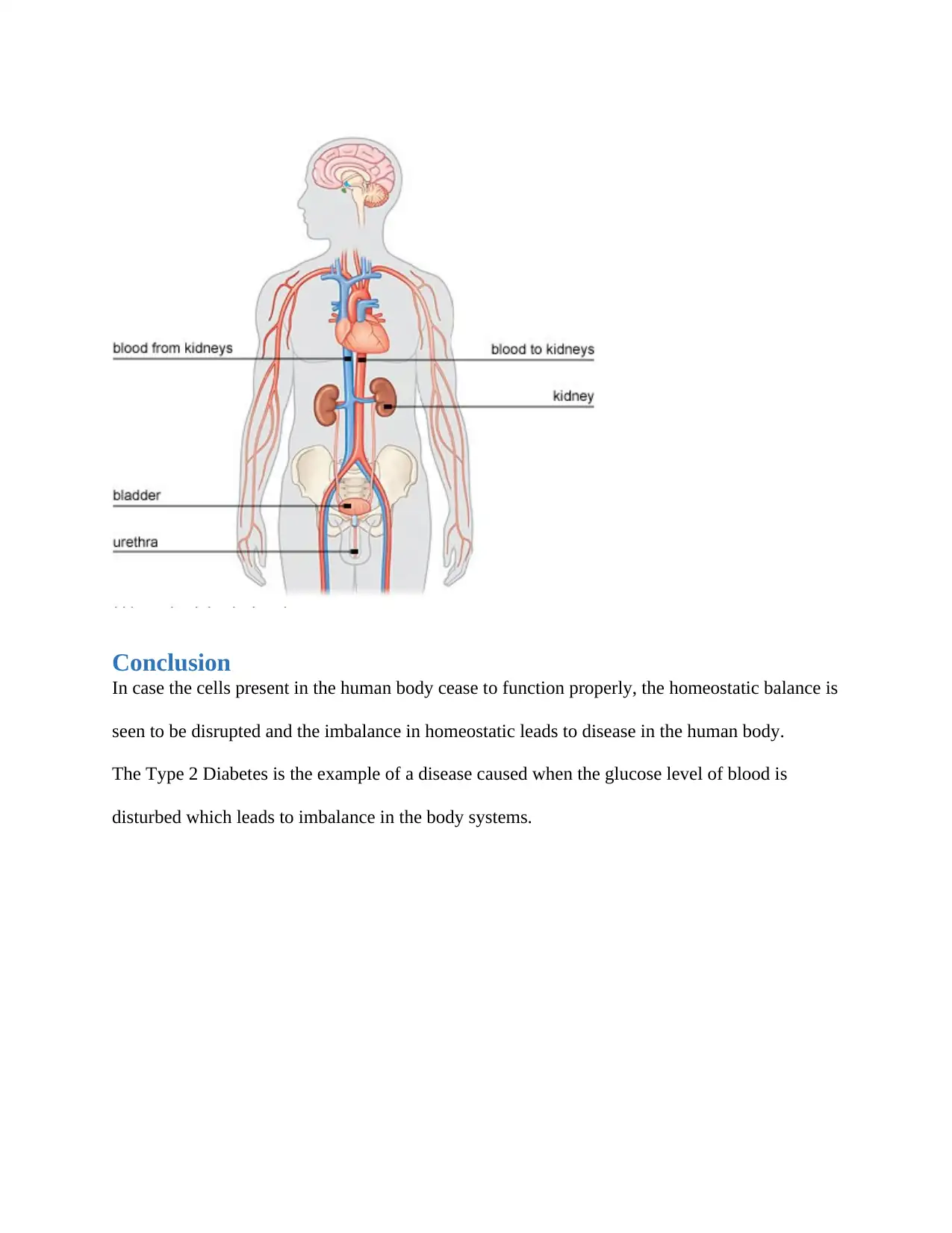
Conclusion
In case the cells present in the human body cease to function properly, the homeostatic balance is
seen to be disrupted and the imbalance in homeostatic leads to disease in the human body.
The Type 2 Diabetes is the example of a disease caused when the glucose level of blood is
disturbed which leads to imbalance in the body systems.
In case the cells present in the human body cease to function properly, the homeostatic balance is
seen to be disrupted and the imbalance in homeostatic leads to disease in the human body.
The Type 2 Diabetes is the example of a disease caused when the glucose level of blood is
disturbed which leads to imbalance in the body systems.
⊘ This is a preview!⊘
Do you want full access?
Subscribe today to unlock all pages.

Trusted by 1+ million students worldwide
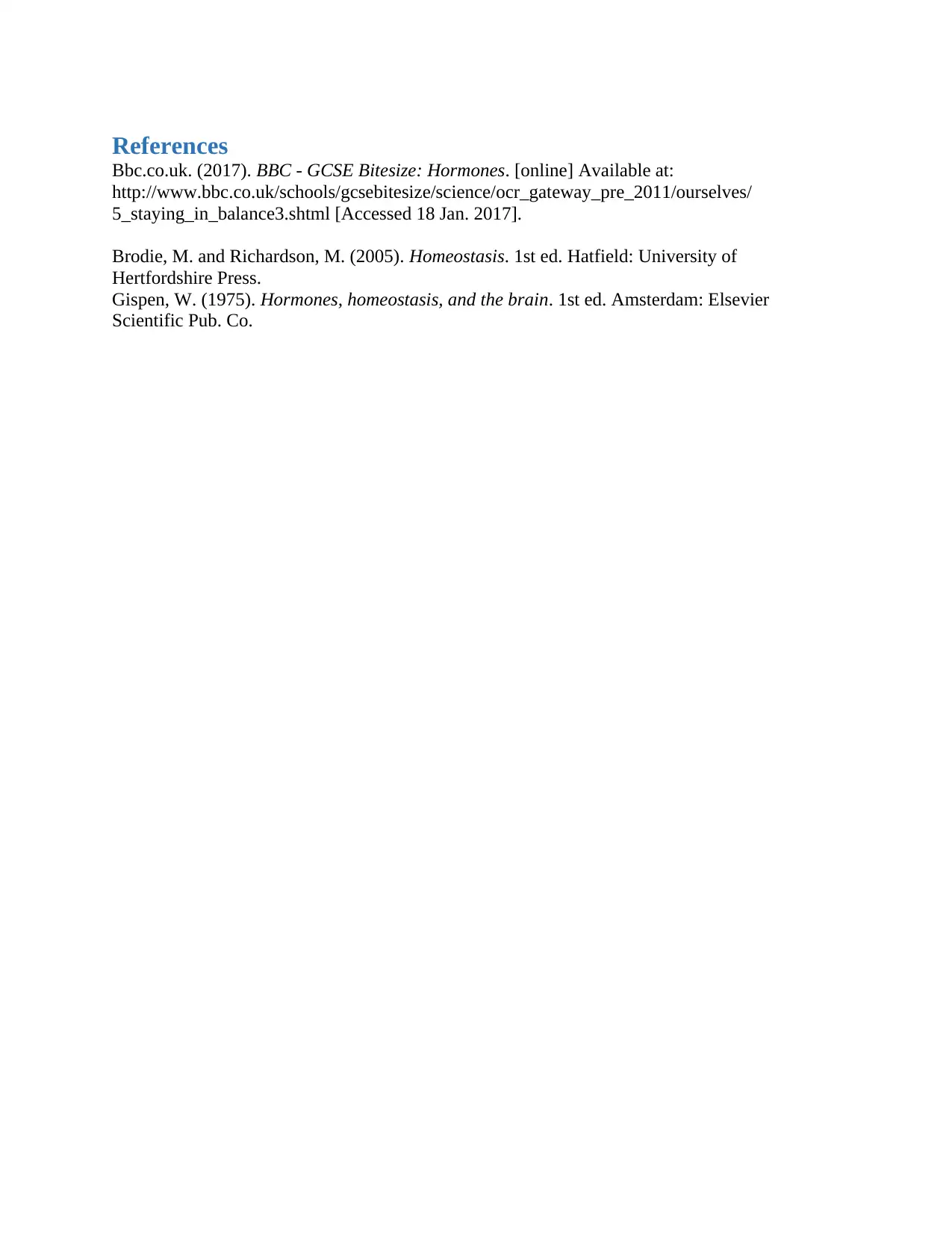
References
Bbc.co.uk. (2017). BBC - GCSE Bitesize: Hormones. [online] Available at:
http://www.bbc.co.uk/schools/gcsebitesize/science/ocr_gateway_pre_2011/ourselves/
5_staying_in_balance3.shtml [Accessed 18 Jan. 2017].
Brodie, M. and Richardson, M. (2005). Homeostasis. 1st ed. Hatfield: University of
Hertfordshire Press.
Gispen, W. (1975). Hormones, homeostasis, and the brain. 1st ed. Amsterdam: Elsevier
Scientific Pub. Co.
Bbc.co.uk. (2017). BBC - GCSE Bitesize: Hormones. [online] Available at:
http://www.bbc.co.uk/schools/gcsebitesize/science/ocr_gateway_pre_2011/ourselves/
5_staying_in_balance3.shtml [Accessed 18 Jan. 2017].
Brodie, M. and Richardson, M. (2005). Homeostasis. 1st ed. Hatfield: University of
Hertfordshire Press.
Gispen, W. (1975). Hormones, homeostasis, and the brain. 1st ed. Amsterdam: Elsevier
Scientific Pub. Co.
1 out of 7
Related Documents
Your All-in-One AI-Powered Toolkit for Academic Success.
+13062052269
info@desklib.com
Available 24*7 on WhatsApp / Email
![[object Object]](/_next/static/media/star-bottom.7253800d.svg)
Unlock your academic potential
Copyright © 2020–2025 A2Z Services. All Rights Reserved. Developed and managed by ZUCOL.





